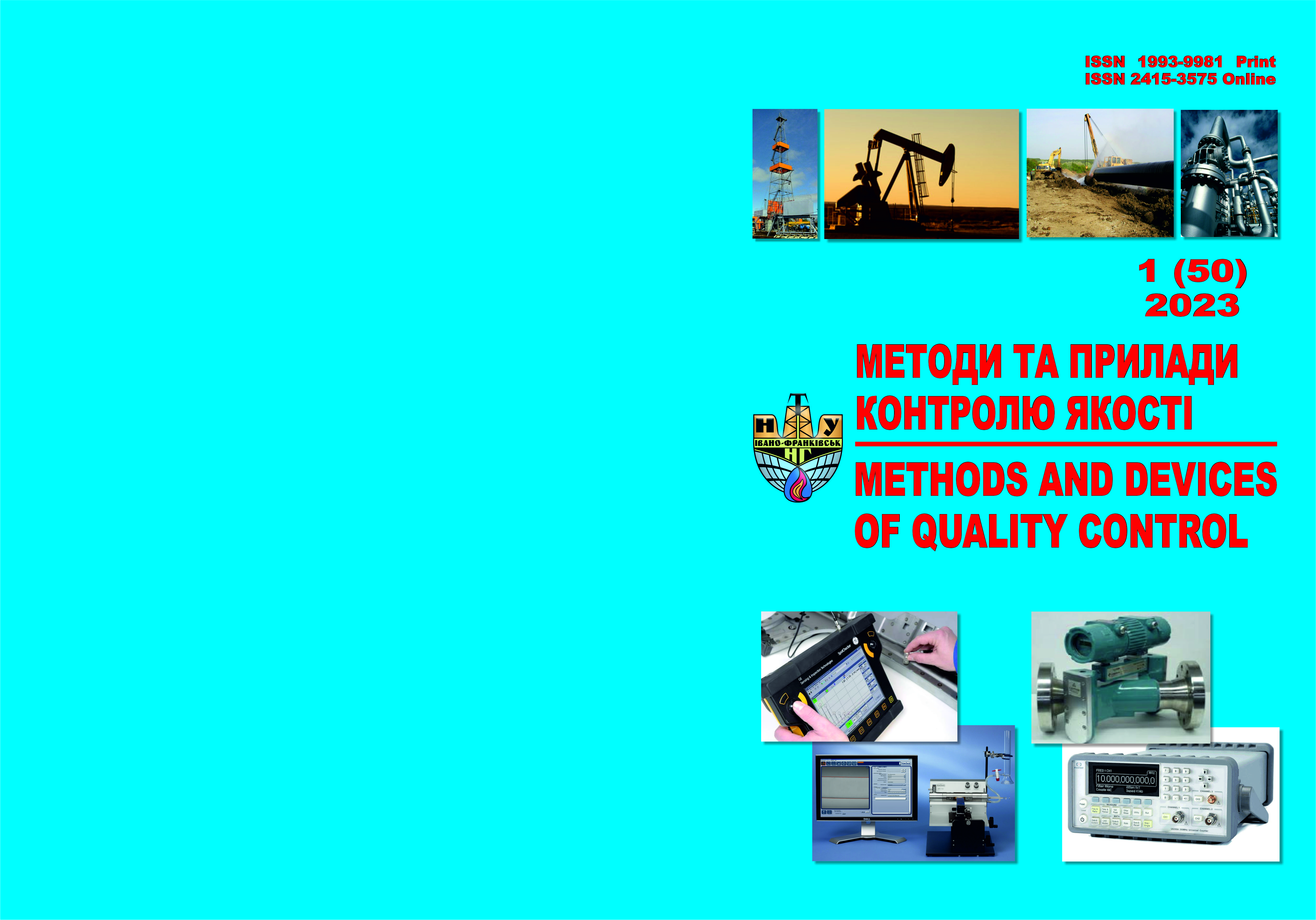ПОБУДОВА МАТЕМАТИЧНОЇ МОДЕЛІ БУРОВОГО НАСОСНОГО АГРЕГАТУ ДЛЯ АВТОМАТИЧНОЇ СИСТЕМИ КЕРУВАННЯ ТИСКОМ НА ЙОГО ВИХОДІ
DOI:
https://doi.org/10.31471/1993-9981-2023-1(50)-48-59Ключові слова:
математична модель, буровий насосний агрегат, автоматична система керування, тиск, передавальна функціяАнотація
Розглянуто функціональну схему системи оптимального керування процесом механічного буріння, що має ієрархічну структуру. Нижній рівень системи включає буровий насосний агрегат, складовими частинами якого є система “привод — буровий насос” та пневмокомпенсатор. Основною задачею бурового насосного агрегату є забезпечення постійного моменту на валу, що дає змогу підтримувати постійним тиск промивальної рідини на вході в свердловину. Розроблено аналітичні математичні моделі для бурового насоса з асинхронним приводом та пневмокомпенсатора. Показано, що розроблені математичні моделі мають вигляд диференціальних рівнянь першого порядку і є нелінійними. Для їх лінеаризації нелінійні залежності було розкладено в ряд Тейлора. В розроблену математичну модель пневмоконденсатора входить значення коефіцієнта стисливості повітря. Введення такого поправочного коефіцієнта пояснюється тим, що при робочому тиску подачі бурового розчину в свердловину (від 14 МПа до 18 МПа) поведінка газу відрізняється від ідеального. Визначено, що коефіцієнт стисливості повітря є функцією двох аргументів — тиску і температури, які є змінними величинами. Дану функцію було апроксимовано регресійним поліномом другого порядку, а значення коефіцієнтів обчислено за методом найменших квадратів за допомогою програмного забезпечення в середовищі MatLab. Для візуалізації отриманих результатів побудовано графік залежності коефіцієнта стиснення від тиску та температури, з якого видно що обчислені значення коефіцієнтів zy співпадають з “експериментальними значеннями” з високою точністю. Для розроблених математичних моделей здійснено перетворення за Лапласом, що дозволило побудувати структурні схеми бурового насосного агрегату та його компонент. На основі отриманих схем синтезовано систему автоматичного керування бурового насосного агрегату з асинхронним приводом.
Завантаження
Посилання
M. I. Horbiychuk, D. R. Kropyvnytskyi. Mathematical model of the process of deepening the well during drilling with screw downhole engines. Collection of scientific papers of Admiral Makarov National Shipbuilding University. 2021. No. 1 (484). P. 68-74. [in Ukrainian]
M. Horbiychuk, D. Kropyvnytskyi, V. Kropyvnytska. Improving empirical models of complex technological objects under conditions of uncertainty. Eastern-European Journal of Enterprise Technologies. 2023. No. 2 (122). P. 53-63.
Gorbiychuk M. I., Kropyvnytskyi D. R. Optimal control of the well deepening process taking into account the state of the bit arming. Bulletin of the Khmelnytskyi National University. 2023. Volume 1. No. 1, (317). P. 58-66. [in Ukrainian]
Kropyvnytska V. B. The well drilling process as a complex system with multi-criteria evaluation of processes. Quality control methods and devices. 2018. No. 2. P. 69-76. [in Ukrainian]
Kotskulich Ya.S., Orynchak M.I., Orynchak M.M. Drilling flushing fluids. Ivano-Frankivsk: "Fakel", 2008. 500 p. [in Ukrainian]
Making decisions when choosing bits and mode parameters of drilling depending on the nature of the initial information / G. M. Efendiev, S. A. Aliyev, M. D. Sarbopeeva [and others]. Geoinformatics, 2016. No. 3. P. 30–39. [in Ukrainian]
Ogorodnikov P.I., Svitlytskyi V.M., Ugryumov M.V. The influence of downhole drives on wave processes in the drill string. Oil and gas industry of Ukraine. 2020. No. 1. P. 3-7. [in Ukrainian]
T. V. Tabachnikova and L. V. Shvetskova. Results of mathematical modeling of the mud pump electric drive operation with the compensation unit in the circuit. IOP Conference Series Materials Science and Engineering. July, 2020. 012015. DOI:10.1088/1757-899X/860/1/012015
Zheng Zhou, Yuanbiao Hu, Baolin Liu, Kun Dai, Yudong Zhang. Development of Automatic Electric Drive Drilling System for Core Drilling. Applied Sciences, 2023. Volume 13, Issue 2. 1059 https://doi.org/10.3390/app13021059
Kaluzhnyi, B., & Malyar, A. Simulation of the start-up electric drive of a sucker rod pump installation. Electrotechnics and Computer Systems. 2019. Vol 66. P. 167-169.
Leonov, G.A.; Kuznetsov, N.V.; Kiseleva, M.A.; Solovyeva, E.P.; Zaretskiy, A.M. Hidden Oscillations in Mathematical Model of Drilling System Actuated by Induction Motor with a Wound Rotor. Nonlinear Dyn. 2014. Vol 77. P. 277–288.
Sementsov G.N., lagoyda A.I. Statistical identification of dynamic characteristics of boring pumping installations for optimization control. Modern engineering and innovative technologies. 2019. No. 2(09-02). P. 12-30. DOI: 10.30890/2567-5273.2019-09-02-006
Fundamentals of an electric drive [Text]: lecture notes / incl. V.V. Lyshuk, S.P. Litkovets. – Lutsk: Technical College of Lutsk National Technical University, 2020. 168 p. [in Ukrainian]
Fundamentals of an electric drive: a textbook / Yu.M. Lavrinenko, P.I. Savchenko, O.Yu. Sinyavskyi, D.G. Voytyuk, V.V. Savchenko, I.M. Hungry. K.: Lira-K Publishing House, 2017. 524 p. [in Ukrainian]
Kostinyuk L. D. Mathematical and structural models of asynchronous motors built on the basis of single-phase substitute circuits. Bulletin of the Lviv Polytechnic National University. 2008. No. 615: Electrical and electromechanical systems. P. 46-50. [in Ukrainian]
O. A. Pashchenko. The influence of hydrostatic pressure on energy consumption when drilling wells. Rock-destroying and metal-working instrument — technique and technology of its manufacture and application, 2016. Vol. 19. P. 107-112. [in Ukrainian]
Kovetsʹka YU.YU., Dmytrenko N.P., Skitsʹko O.I., Plakhotnya L.V. Teploobmin pry pryrodniy konvektsiyi hazu Van-der-Vaalʹsa. Teplofizyka ta teploenerhetyka. 2022, Vol.44. № 1. P. 5-12. [in Ukrainian].
Himmelblau David M., Riggs James B. Basic Principles and Calculations in Chemical Engineering: Eighth Edition. Prentice Hall, 2012. 857 p.
Andrew F. Hayes. Statistical methods for communication science. New Jersey, 2015. 507 p.


.png)




